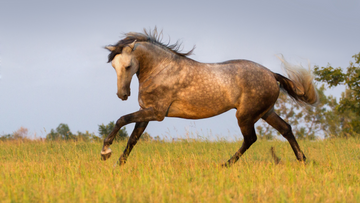The Basics of Horse Conformation
Horse conformation is the physical makeup of the horse. Each breed has an ideal standard for what a horse should look like. Conformation is mainly genetic. Most traits of conformation are simply the traits a horse is born with. However, conformation can be affected by the horse's health, exercise, and performance in competition.
Definition and Importance
When you assess your horse’s conformation, you must assess his:
- Skeletal Structure
- Body Shape
- Proportions
- Leg Alignment
- Shoulder Angle
- Back Length
Overall, horses with good body structure are less likely to get injured because their bodies are aligned properly for movement. We see the benefits of conformation in all equestrian sports, from racing to dressage.
Breeders have a strong understanding of conformation because a horse with good body structure is more valuable. The best buyers and trainers of horses also understand conformation well.
Horse Conformation Assessment

Before you purchase a horse, consider assessing his conformation. Conformation is not the only sign of performance. That being said, you will also want to determine the horse’s overall demeanor, stamina, and temperament.
Head and Neck
The neck of your horse should be muscular and well-set. Additionally, it should be flexible and long enough to allow for movement and turning. You will see large eyes on his head and a convex profile.
Body and Topline
The body of your horse should have well-defined withers and a strong topline. It should show a stance of power and balance. Additionally, you should see a deep girth. Overall, the back should be long enough to allow for flexible and balanced movement without being too long.
Horses should have muscular and rounded bodies. A well-sloped croup is ideal in racing because it produces more effective propulsion.
Forequarters
The forequarters of a horse are his shoulders and front legs. All things considered, the front legs should be straight and powerful. You should see equal weight distribution across both legs. Strong forequarters are especially important in competitions like jumping and cutting.
The chest should be powerful and proportional to the rest of your horse. Otherwise, the shoulders ideally should be smooth and sloped to form a 45-degree angle.
Hindquarters
The hindquarters are the back legs, and hips of a horse. These legs are where your horse’s power resides. The hindquarters deliver the thrust and speed needed for horses to run and jump. Check that your horse is proportional across the hips and to the forequarters.
Legs and Hooves
The lower legs and hooves should be free of swelling. Additionally, your horse should balance on all four legs equally. The hooves should be proportional to the size of your horse. Finally, the hooves should align directly under the leg. Proper alignment can help avoid injury later in life. Of course, regular hoof care is still vital.
Balance and Symmetry
In addition to looking at your horse's muscles and bones, check the spine, hips, and shoulders balance. Moreover, the muscles along the back, legs, and neck should be symmetrical.






















